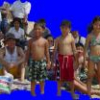Free Online Productivity Tools
i2Speak
i2Symbol
i2OCR
iTex2Img
iWeb2Print
iWeb2Shot
i2Type
iPdf2Split
iPdf2Merge
i2Bopomofo
i2Arabic
i2Style
i2Image
i2PDF
iLatex2Rtf
Sci2ools
ICCV
2007
IEEE
2007
IEEE
Recovering Occlusion Boundaries from a Single Image
Occlusion reasoning, necessary for tasks such as navigation and object search, is an important aspect of everyday life and a fundamental problem in computer vision. We believe that the amazing ability of humans to reason about occlusions from one image is based on an intrinsically 3D interpretation. In this paper, our goal is to recover the occlusion boundaries and depth ordering of free-standing structures in the scene. Our approach is to learn to identify and label occlusion boundaries using the traditional edge and region cues together with 3D surface and depth cues. Since some of these cues require good spatial support (i.e., a segmentation), we gradually create larger regions and use them to improve inference over the boundaries. Our experiments demonstrate the power of a scene-based approach to occlusion reasoning.
Computer Vision | Depth Cues | Depth Ordering | ICCV 2007 | Occlusion Boundaries | Occlusion Reasoning | Region Cues |
| Added | 14 Oct 2009 |
| Updated | 30 Oct 2009 |
| Type | Conference |
| Year | 2007 |
| Where | ICCV |
| Authors | Derek Hoiem, Andrew N. Stein, Alexei A. Efros, Martial Hebert |
Comments (0)

